THE SINGAPORE SERIES – CHAPTER 10

Audience anxiety
In 2017, I visited a show a of late ceramic artist called Iskander Jalil, in dialogue with the young Singaporean artist Gerald Leow at the National Gallery of Singapore. Gerald’s day job was set design, and it showed from his intervention in the show, which was very subtle. He built a metal structure evoking the traditional house of Inskandar with a simple metal outline. I was looking forward to seeing the show since the artist mentioned that he was doing research from it in our first interview, and I peered out curiously into the room. Before I had the chance to set foot inside, the gallery sitter, gentle as ever, handed me a flyer: “Please find here some information about the show. You will find also the interview of the curator with Gerald Leow and some information about the content of the show. Please proceed to your left to see the exhibition.” Being a Neapolitan, so a rule-breaker by nature, I was about to blurt out: “Well, what if I want to start from the right?” After all, there was no chronology intended in the work, and there were no other people in room. But instead, I shut up and remembered where I was. And yes, I was in a place where the so-called audience anxiety was real.
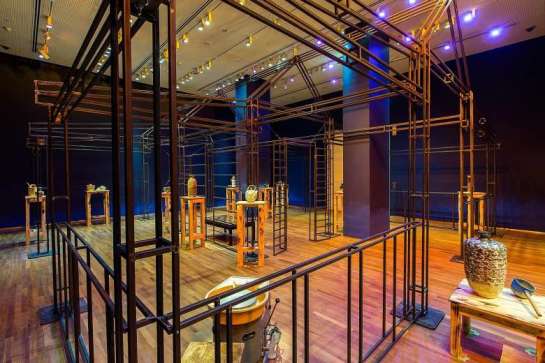
The subject kept on coming up insistently in talks and conversations with artists. In a talk for the finissage of the collective exhibition ‘Still Life’ at Substation, curators Michelle Lim and Charmaine Toh, the then curator at National Gallery Singapore, spelled it out. The curatorial concept for the show was meant to drive the audiences’ perceptions. For the show, the Substation space was kept completely dark, and only one work at a time would be lit up, forcing time-dependent attention on just one work. The time constraints were exactly the same as video-art. By the way, this is precisely the reason why I generally skip video-art. You need to be subdued by its own rule. For a while, the artist becomes the dictator of what you hold most precious: your time.
Since the curators of the Substation show were also working for museums, the subject expanded into whether or not guiding the fruition of works should occur. “Shall we provide text and information with the exhibition, or shall we leave the audience freer to make their own readings?”, they asked. How the curators verbally framed the matter sounded very interesting to me: “There is a lot of resistance against letting the work and the context be amorphous”. I felt that the unspoken but underlying belief here was that without curation, the art wouldn’t be able to stand by itself. From the point of view of the curators, it would have been that pushing for one single concept in the work would convey a stronger meaning, and make the work more powerful. Again, between the lines, you could read that in their view the measure for good art here was its effectiveness in delivering a message. Its strength was to find coherence in it. Coming from the European art world, where strength in an artwork equals multiplicity of meanings and point of views, that sounded interesting to me. The curators were using the language of effectiveness. The language of efficiency targeting an aim. In other words, the language of bureaucracy.
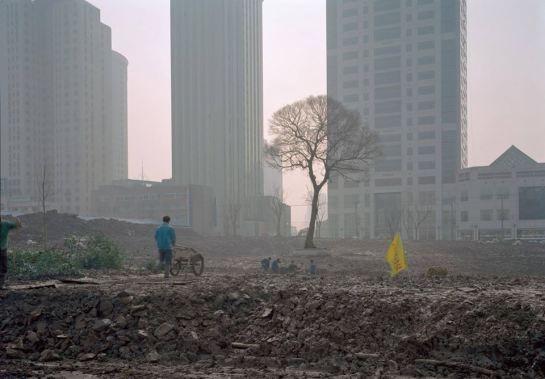
What I mean when I say the language of bureaucracy is a kind of communication which is direct and aims to narrow down the possibilities to the minimum. You don’t want to be open to ambiguities and interpretations when filling the application for your taxes. The language of bureaucracy also appeals to a shared, solid knowledge which is sort of “third person”. In other words, “the official truth”. In describing artworks, the language of bureaucracy takes the shape of the title of the artwork, the year of production, the name of the artist, its country and perhaps its date of birth.
We find this kind of language more and more often in art criticism too. On one hand, I’m not crazy about art criticism which takes the form of a poetical departure, ending up not having anything to do at all with the work. I would find the literary ability of the writer perhaps best used elsewhere. However, the kind of art writing which only describes the work in terms of size, weight, materials, price, time and place where it has been exhibited, is stifling. The language of bureaucracy is of course a safer language, which gives us the reassurance of something real, concrete, practical. It is a language that the market needs, and it underlies the fear of the unpredictable. Conversely, the language of imagination is the language of the possibilities. It dismantles the preconceived categories which are so useful for us to orientate in the world – including the different systems of science – and allow us to access a space where these are more fluid. It allows categories to appear as they are. Made by humans on the earth.
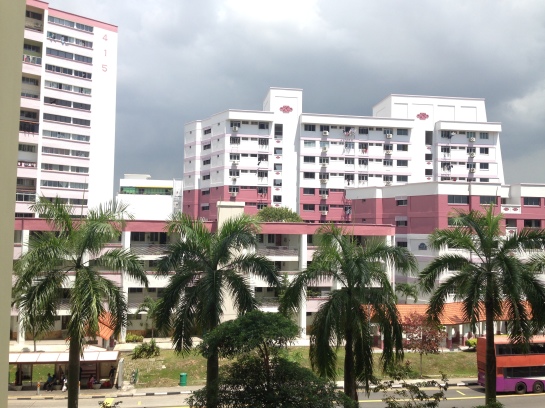
The work and its caption: Robert Zhao Open House
A nerdy contemporary art joke is that nowadays it is no more the caption describing the work, but it is rather the artwork illustrating the caption. An artist who plays in the intersection on the language of bureaucracy and the language of imagination is Robert Zhao Renhui. His works are famous for having super long descriptions, or even companion books, which are part of the artwork itself. This shift consists of the fact that the art is not the artwork itself. The art happens in the way the spectator looks at the work, and the way they relate with the textual information. The explanation provided for the animal, the tree, the object or the photographs which the artist presents is indeed sometimes made up. And yet, just because it is printed on a tag near the work, the audience sees takes it as valid. As the truth.
But the work of Robert doesn’t stop there. He took this concept a step further, challenging the notion of institutional recognition. Since its inception in the art world, the artist operated under the fictional organisation called “The Institute of Critical Zoologist”. The blurred line between art and reality, official truth and fiction gave him even recognition in the scientific world for the discovery of a new species of insect. Until he revealed that, well, it was only an artwork. As one can see it, the whole operation was an artwork in itself.
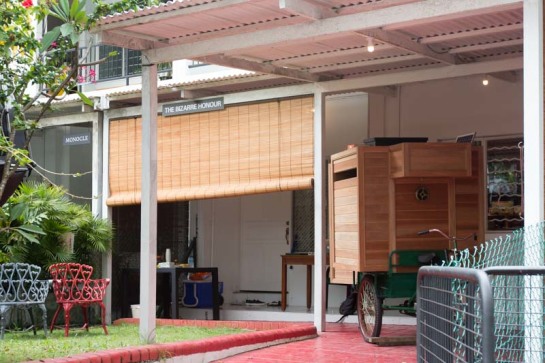
Knowing the artist as one that would have long explanations coming with the work, I was surprised to visit in 2017 one show – or an entire artwork might be a more fitting definition – where no tag was to be found. Even his name was erased from the show. It was one edition of Open House! the brainchild of Alan Oei, which took place in the expat neighborhood of Holland Village. I stepped in the front of an unassuming colonial white house, whose porch was covered by a typical bamboo shutters. A guy was quietly sitting at the desk.
“Hi, I’m here for Robert Zhao’s work…”
The guy hastily put a finger to his mouth: “Shhh! Don’t say that name out loud! The work is supposed to be anonymous!” As the two previous visitors came out from their visit to the house/artwork, the guy smiled to them reassuringly, hoping they didn’t hear. Then he turned back to me and cleared his throat, giving me the official explanation: “This is an artwork by a group of anonymous artists. There will be no tags or explanations of each work. You can roam free in every room and touch everything that has this sign.” He showed me a hive-like mark. “A maximum of two visitors are allowed in, for 30 minutes. At the end you will find a book with your name on it that you can either take or leave there.” It sounded a bit exoteric, and I kind of liked it. He opened the door and let me into the fantasy land of Robert… I mean… the anonymous group of artists.
From the very first moment, I loved the very free approach where you don’t feel the need to define what you are seeing, smelling and experiencing as art, fiction or truth. It was just about perception and curiosity. Also, as a notorious snooper – I’m a journalist after all – the prospect of going through papers scattered on someone else’s desk, though albums of old pictures and sneaking into rooms was pretty enticing. Of course the work was very distinctively Robert, comprehensively of all his botanical and environment-like obsessions. “It looks very much like my studio”, he admitted when we talked about it a few days later. The whole show seemed to me to be related to how culture tries to interpret and deal with nature, based on its own categories. “The work is most of the things I’m concerned with in my practice,” explained Robert. “It is also about how I see Singapore and it is quite personal to the work. It is also about this thing about our history, because last year we were very interested in that, with the 50 year anniversary of Singapore, so I started to think about how we can look at our history. And what I saw was a lot of violence… a lot of control.”
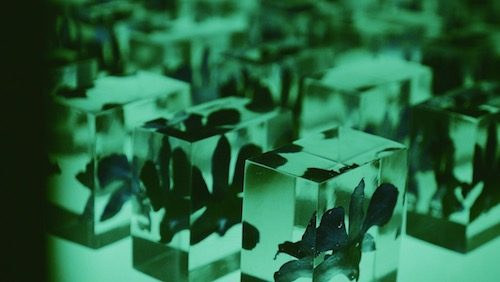
As we mentioned earlier, the problem the whole oeuvre of Robert Zhao is that it emphasizes our conception of truth and our relationship with it. Part of it is how much the presence of a document would legitimize things in history and perhaps also create truth. In the show, a room presented a few pictures and documents of coconut pearls. I asked him what was it all about. “I had many pictures of coconut plantations and I didn’t know what to do with them. In the 1900s, Singapore was busy cultivating coconuts. Today this kind of industry has disappeared because it is not profitable. But some coconut trees are still around. They are some hundreds of years old. I thought, what if Singaporeans would cultivate coconut pearls? The idea of the coconut pearl itself is already pretty crazy. And so what if I edited the images as if the coconut oil plantations looked more like coconut pearl plantations? It is a story.” I jumped on the chair as – with my embarrassing botanical ignorance – I was already sold on the idea that these coconut pearls might have been real: “Oh ok, so it wasn’t a thing that actually exists? Damn, your work is always like that!” I said feeling completely fooled.
“But there is a lot of evidence documenting it,” said the artist completely engrossed by his subject matter; “There are drawings of pearl coconuts by a Dutch biologist in Java. There is only one good academic paper about it, and he said coconut pearls are extremely rare. It says that they probably don’t actually exist, but, they are extremely rare. Also the documents in the installation and the book are real. So I just put a lot of real things to form something not real. The whole exhibition is like that!”
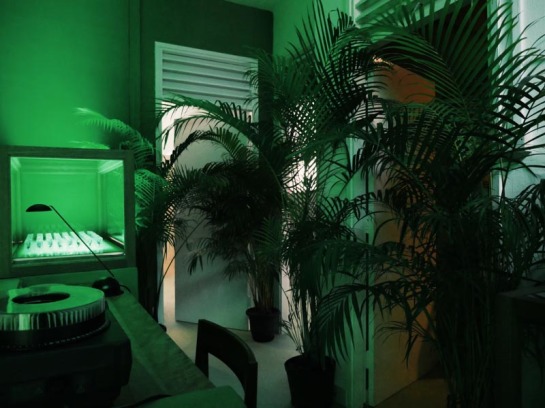
I told him that one part of the Open House which I really like was the bedroom of a child which was built under the staircase. It really reminded me of the wonder for discovery from when you are a child, where you try to discover the world and you absorb everything and then question what is true and what is not. I asked him if it was just a reconstruction of an ideal room, or if it was something from his childhood. My intuition was right, as all the objects were actually from his childhood room. In that regard, I was surprised to see so many Christian figures, not only in the child room, but in the entire installation. What surprised me was seeing this stark juxtaposition between two worldviews which are seen usually as opposite; that of science and that of the Christian religion. It made me think about the thesis of Italian philosopher Umberto Galimberti, who thinks that both systems are not to be seen as polar opposites, as they are based on a common assumption: that the human being is something that can be improved. In Galimberti’s views on both Positivism and Christianity put a lot of emphasis on the future as a place of redemption; while one salvation is to reach through progress and discovery, the other through prayers and good deeds. I kept these reflections for myself, as I was curious to hear from the artist his reasons for this choice. “I have never really thought about it, but perhaps all of my concerns with nature are precisely because I’m Christian,” he said. “And you know when you said that God created the earth and appointed us to oversee everything and intended for humans to be a good steward of nature. So it is very part of me. I’m not embracing it, I feel there is something very strange in how we try to be a master and control things. So for me, the theme of nature in Singapore is very tense.”
We will see in the last chapter of this book how the way in which the attitudes of Singapore towards nature will be what is underlying this fixation with the idea of bureaucracy, categories and imagination.




